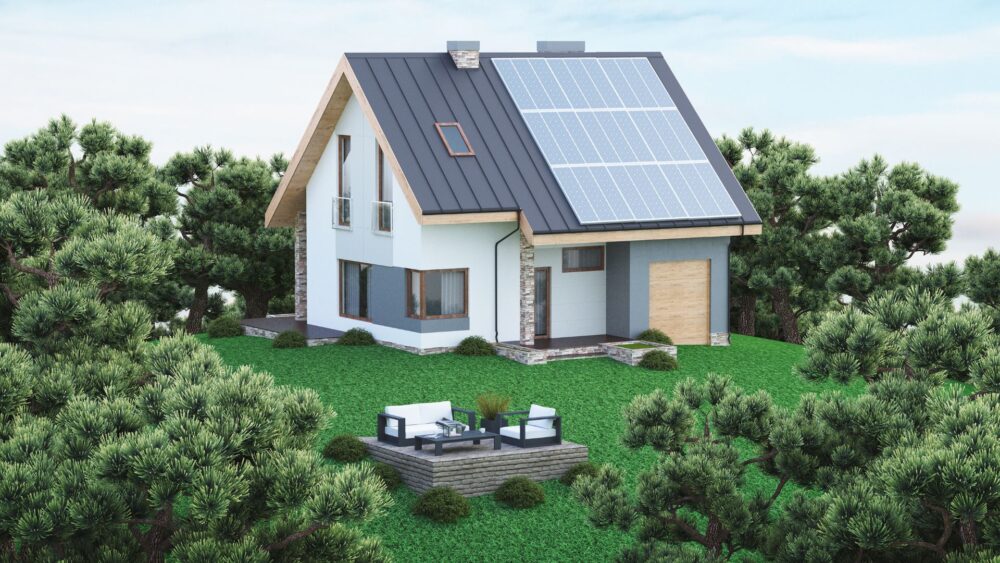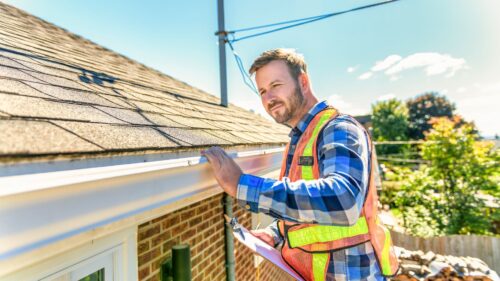Thinking about giving your home a makeover that also gives back to the planet? You’re not alone. In this guide, you’ll discover the wonders of eco-friendly roofing options that not only last a long time but also help save on energy bills – and let’s not forget, they look pretty stylish too. From metal roofs known for their longevity to clay tiles that bring elegance atop sustainability, let’s explore how these options stack up.
Understanding Sustainable Roofing
What Is Sustainable Roofing?
Sustainable roofing is all about using eco-friendly materials and practices that minimize environmental impact. It’s a holistic approach that considers the entire lifecycle of a roof, from the sourcing of raw materials to the disposal of old roofing.
The goal? To create a roof that not only protects your home but also contributes to a greener planet. Sustainable roofing materials are often made from recycled or renewable resources, and they’re designed to last longer and perform better than traditional options.
Why Choose Eco-Friendly Roof Materials?
There are plenty of reasons to go green with your roof. For starters, eco-friendly roofing can help reduce your carbon footprint and minimize waste. Many sustainable materials are also more durable and energy-efficient, which means they can save you money on repairs and utility bills in the long run.
Plus, let’s be real – it just feels good to make a choice that’s better for the environment. When you go for sustainable roofing, think of it as your personal contribution to a brighter, greener future for us all.
Top Sustainable Roofing Materials for Your Home
Metal Roofs: Best for Long-Term Sustainability
Metal roofs are like the superheroes of the roofing world. These beauties are pretty much the superheroes of their category, boasting lifespans that can easily stretch beyond 50 years with just a bit of care and attention. And when it’s finally time to replace them, metal roofs are 100% recyclable.
But that’s not all – metal roofs are also great at reflecting heat, which can help keep your home cooler in the summer and reduce your energy bills. Talk about a win-win.
Clay Tiles: Eco-Friendly Elegance
If you’re looking for a roofing material that’s both beautiful and environmentally friendly, look no further than clay tiles. Crafted from the earth’s own offerings, clay and water, these tiles are not only kind to our planet but built to stand the test of time—literally for hundreds of years.
Clay tiles are also great at regulating temperature, keeping your home cool in the summer and warm in the winter. And with their timeless beauty, they can add a touch of elegance to any home.
Green Roofs: Urban Areas’ Oasis
Green roofs, also known as living roofs, are like a little piece of nature right on top of your home. They’re made by covering the roof with a waterproof membrane, adding a growing medium, and planting vegetation.
Not only do green roofs look amazing, but they also offer a ton of environmental benefits. They can help reduce stormwater runoff, improve air quality, and even provide a habitat for local wildlife. Plus, they can help insulate your home and reduce energy costs. It’s like having your own personal oasis in the middle of the city.
Slate Roofing: Durable and Natural Option
Slate, with its natural toughness and durability, can stand the test of time for more than a hundred years if you take good care of it. It’s resistant to fire, mold, and pests, making it a low-maintenance choice for eco-conscious homeowners.
Yes, you might pay a bit more at the start for slate roofing, but its long-lasting quality and classic look are solid reasons to see it as an investment worth making. Plus, because it’s a natural material, it can be recycled or repurposed at the end of its life.
Benefits of Choosing Eco-Friendly Roofing Options
Reducing Cooling Costs with Reflective Materials
One of the top perks of choosing sustainable roofing materials is how great they are at bouncing back heat. By bouncing sunlight back into the atmosphere instead of absorbing it, reflective roofs can help keep your home cooler and reduce the need for air conditioning.
This not only saves you money on energy bills but also helps reduce your carbon footprint. According to the U.S. Department of Energy, a cool roof can lower roof surface temperatures by up to 50°F, leading to significant energy savings.
Mitigating Greenhouse Gas Emissions
By choosing sustainable roofing materials, you’re not just benefiting your own home – you’re also helping to mitigate greenhouse gas emissions on a larger scale.
Many eco-friendly roofing options, like metal and clay tiles, have a lower carbon footprint than traditional materials like asphalt shingles. And by reducing energy consumption through reflective and insulating properties, sustainable roofs can help decrease the overall demand for fossil fuels.
Installation and Maintenance of Sustainable Roofs
Ensuring Proper Installation for Maximum Efficiency
To get the most out of your sustainable roof, proper installation is key. Teaming up with pros who really get the nitty-gritty of eco-friendly materials can make all the difference.
For example, green roofs require a specialized waterproofing system and drainage layer to ensure the health of the vegetation. Metal roofs need to be properly sealed and fastened to prevent leaks and corrosion. Putting your money into a top-notch installation means you’re setting up your eco-friendly roof to give its best performance, year after year.
Maintaining Your Eco-Friendly Roof for Longevity
While sustainable roofing materials are generally low-maintenance, they still require some care to maintain their performance and appearance. Regular inspections can help catch any potential issues early on, before they turn into bigger problems.
For green roofs, this may mean periodically trimming and fertilizing the vegetation. For metal and tile roofs, it’s important to keep them clean and free of debris to prevent damage and ensure proper drainage. Give your eco-friendly roof a bit of tender loving care, and it’ll keep shielding your home while doing good for the planet for many years to come.
Making Your Existing Roof More Sustainable
Adding a Cool Roof Coating to Reflect Heat
If a full roof replacement isn’t in the cards, you can still make your existing roof more sustainable with a cool roof coating. These specialized paints and coatings are designed to reflect sunlight and reduce heat absorption.
According to the U.S. Department of Energy, a cool roof coating can reduce roof surface temperatures by up to 50°F, leading to significant energy savings. And because they can be applied to most existing roof types, they’re a cost-effective way to boost your roof’s eco-friendliness.
Setting Up Solar Panels for Energy Production
Another way to make your existing roof more sustainable is by installing solar panels. When you tap into the sun’s power with solar panels, you’re stepping into a world of clean, renewable energy that powers your home while cutting down on fossil fuel use.
With the magic of today’s tech, solar panels have hit a sweet spot—they’re not just better at soaking up the sun; they’re also easier on your wallet than you might think. Many states even offer incentives and tax credits to help offset the initial cost of installation. With solar panels, you can turn your roof into a mini power plant and save money on energy bills in the process.
Comparing the Environmental Impact of Different Roofing Materials
Asphalt Shingles and Their Environmental Drawbacks
While asphalt shingles are one of the most common roofing materials, they’re not the most environmentally friendly. Made from petroleum byproducts, asphalt shingles have a high carbon footprint and contribute to greenhouse gas emissions during production.
They also have a relatively short lifespan compared to other roofing materials, which means they need to be replaced more frequently. And when it’s time for disposal, asphalt shingles often end up in landfills, where they can take decades to decompose.
On the flip side, when you look at roofing options that are friendlier to our planet—like metal, clay, and slate—you’re talking about materials that don’t weigh as heavily on the environment. They’re often made from recycled or natural materials, have a longer lifespan, and can be recycled or repurposed at the end of their life.
Even green roofs, with their vegetation and growing medium, can have a positive impact on the environment by reducing stormwater runoff, improving air quality, and providing a habitat for local wildlife.
So when it comes to choosing a roofing material, it’s important to consider not just the upfront cost, but also the long-term environmental impact. When you choose sustainable roofing, you’re not just investing in your home—you’re laying the foundation for a cleaner, greener future that our kids and grandkids will thank us for.
Eco-Friendly Roofing FAQs:
What is the most sustainable roof type?
Green roofs take the lead, turning urban spaces into eco havens while slashing energy costs and absorbing rainwater.
What is sustainable roofing?
Sustainable roofing involves materials and practices that lower environmental impact, boost home efficiency, and outlast traditional options.
How can I make my roof more sustainable?
Add cool coatings or solar panels. These upgrades reflect heat or generate power, slicing your bills and carbon footprint.
Are roof shingles eco-friendly?
Metal and clay tiles are greener than asphalt shingles because they last longer and often contain recycled content.
Conclusion
In wrapping up our journey into sustainable roofing, going green with your roof doesn’t mean compromising on quality or aesthetics; it means embracing innovation with both arms open wide—and possibly saving some cash along the way because who said being kind to Earth had to be pricey?
So whether you’re ready to make a switch today or still weighing your options, keep in mind that every little bit helps when building a future where homes are as conscious about their carbon footprint as they are cozy inside. Get free quotes on your roof today by filling out this form.



